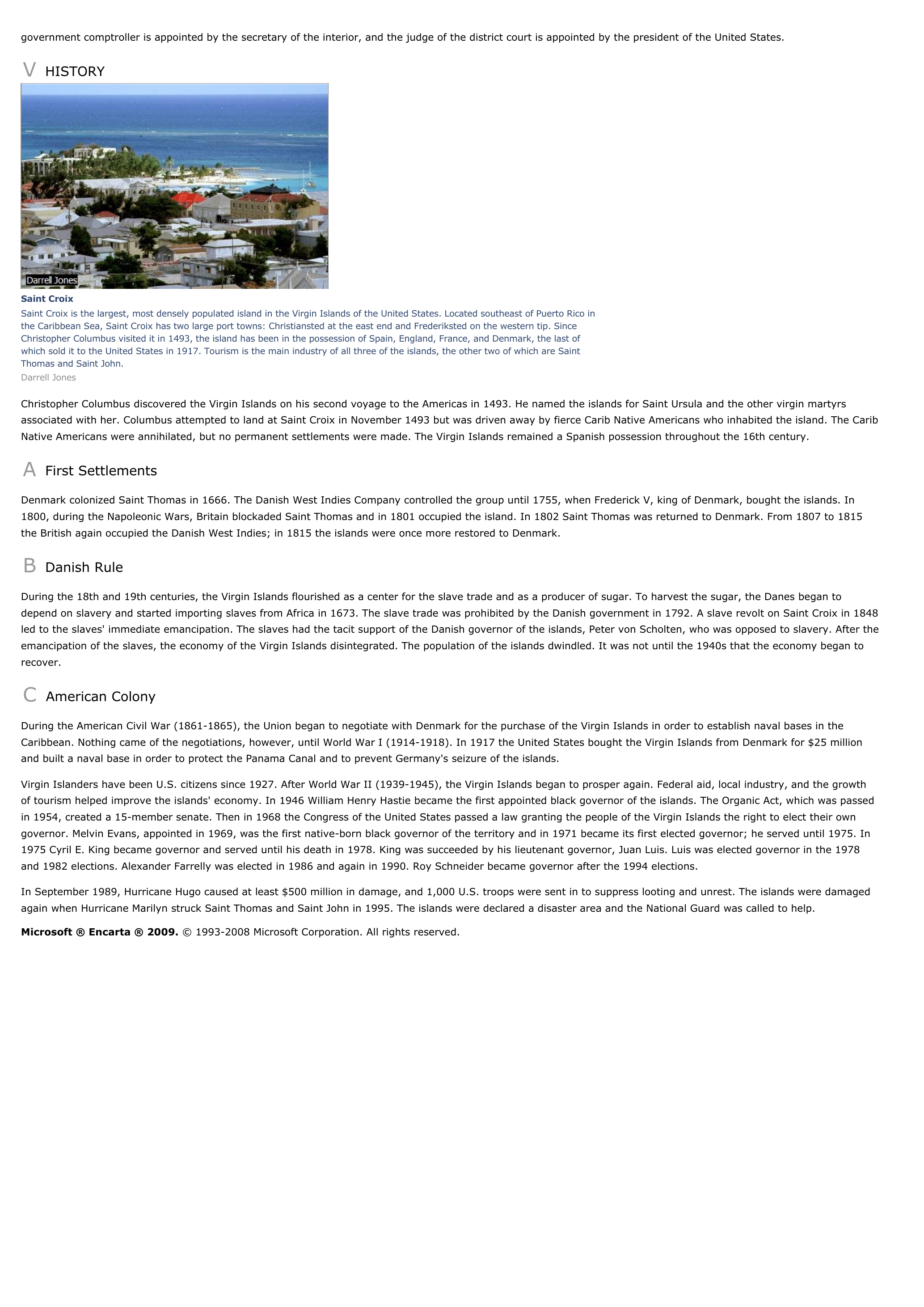Virgin Islands of the United States - geography.
Publié le 27/05/2013

Extrait du document
«
government comptroller is appointed by the secretary of the interior, and the judge of the district court is appointed by the president of the United States.
V HISTORY
Saint CroixSaint Croix is the largest, most densely populated island in the Virgin Islands of the United States.
Located southeast of Puerto Rico inthe Caribbean Sea, Saint Croix has two large port towns: Christiansted at the east end and Frederiksted on the western tip.
SinceChristopher Columbus visited it in 1493, the island has been in the possession of Spain, England, France, and Denmark, the last ofwhich sold it to the United States in 1917.
Tourism is the main industry of all three of the islands, the other two of which are SaintThomas and Saint John.Darrell Jones
Christopher Columbus discovered the Virgin Islands on his second voyage to the Americas in 1493.
He named the islands for Saint Ursula and the other virgin martyrsassociated with her.
Columbus attempted to land at Saint Croix in November 1493 but was driven away by fierce Carib Native Americans who inhabited the island.
The CaribNative Americans were annihilated, but no permanent settlements were made.
The Virgin Islands remained a Spanish possession throughout the 16th century.
A First Settlements
Denmark colonized Saint Thomas in 1666.
The Danish West Indies Company controlled the group until 1755, when Frederick V, king of Denmark, bought the islands.
In1800, during the Napoleonic Wars, Britain blockaded Saint Thomas and in 1801 occupied the island.
In 1802 Saint Thomas was returned to Denmark.
From 1807 to 1815the British again occupied the Danish West Indies; in 1815 the islands were once more restored to Denmark.
B Danish Rule
During the 18th and 19th centuries, the Virgin Islands flourished as a center for the slave trade and as a producer of sugar.
To harvest the sugar, the Danes began todepend on slavery and started importing slaves from Africa in 1673.
The slave trade was prohibited by the Danish government in 1792.
A slave revolt on Saint Croix in 1848led to the slaves' immediate emancipation.
The slaves had the tacit support of the Danish governor of the islands, Peter von Scholten, who was opposed to slavery.
After theemancipation of the slaves, the economy of the Virgin Islands disintegrated.
The population of the islands dwindled.
It was not until the 1940s that the economy began torecover.
C American Colony
During the American Civil War (1861-1865), the Union began to negotiate with Denmark for the purchase of the Virgin Islands in order to establish naval bases in theCaribbean.
Nothing came of the negotiations, however, until World War I (1914-1918).
In 1917 the United States bought the Virgin Islands from Denmark for $25 millionand built a naval base in order to protect the Panama Canal and to prevent Germany's seizure of the islands.
Virgin Islanders have been U.S.
citizens since 1927.
After World War II (1939-1945), the Virgin Islands began to prosper again.
Federal aid, local industry, and the growthof tourism helped improve the islands' economy.
In 1946 William Henry Hastie became the first appointed black governor of the islands.
The Organic Act, which was passedin 1954, created a 15-member senate.
Then in 1968 the Congress of the United States passed a law granting the people of the Virgin Islands the right to elect their owngovernor.
Melvin Evans, appointed in 1969, was the first native-born black governor of the territory and in 1971 became its first elected governor; he served until 1975.
In1975 Cyril E.
King became governor and served until his death in 1978.
King was succeeded by his lieutenant governor, Juan Luis.
Luis was elected governor in the 1978and 1982 elections.
Alexander Farrelly was elected in 1986 and again in 1990.
Roy Schneider became governor after the 1994 elections.
In September 1989, Hurricane Hugo caused at least $500 million in damage, and 1,000 U.S.
troops were sent in to suppress looting and unrest.
The islands were damagedagain when Hurricane Marilyn struck Saint Thomas and Saint John in 1995.
The islands were declared a disaster area and the National Guard was called to help.
Microsoft ® Encarta ® 2009. © 1993-2008 Microsoft Corporation.
All rights reserved..
»
↓↓↓ APERÇU DU DOCUMENT ↓↓↓
Liens utiles
- Virgin Islands of the United States - geography.
- Subject: What are the impacts of racism on black people in the United States
- The Monroe Doctrine In his annual message to Congress in 1823, United States president James Monroe declared that the United States had the right to exclude foreign powers from colonizing in the western hemisphere.
- Tecumseh: "Once a Happy Race" Early in the 19th century, Governor William Henry Harrison of the Indiana Territory made a number of treaties with Native Americans that involved the ceding of land to the United States government.
- Nixon's Resignation Speech Nixon's Resignation Speech August 8, 1974 Richard Milhous Nixon was the first United States president in history to resign from office.

































